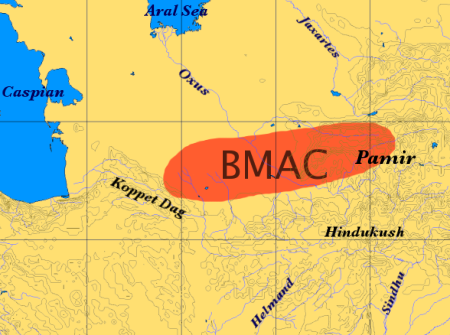

Map courtesy of Wikimedia Commons, will be replacing with my own map soon.
Age: 2300-1000 BCE (Bronze Age [BA]) |
Associated Populations: Eneolithic South-Central Asians, Neolithic Iranians |
Associated Culture: Bactria-Margiana Archaeological Complex |
Associated Maternal Haplogroups: U2, U8, U7a2, J1, J1b, J1b1a3, W, W3a1,W3b, R2, N1a2, N2, I, HV, H, T2c1a |
Associated Sites: Gonur Tepe, Jarkutan, Sappali Tepe, Bustan, Parkhai |
Associated Paternal Haplogroups: J, J1, R, A, CT |
The BMAC (Bactria-Margiana Archaeological Complex) was an urban culture characterized by cities, advanced irrigation technology, and a stratified society that engaged with pastoralists from the Pontic-Caspian steppes, particularly steppe populations associated with the Indo-Iranian language group. The culture is associated with a rich artistic tradition, with intricate figurines and statuettes. The BMAC succeeds and is descended from Neolithic South-Central Asian cultures.
The BMAC population was modeled by Narasimhan et al. as a mixture of Neolithic Iranians, Neolithic Anatolians, Neolithic West Siberians, and a small portion of Ancient Ancestral South Indians (a population source found typically in Andamanese populations).

Since the BMAC population was descended from Neolithic South-Central Asian populations, modeling the BMAC population using Neolithic South-Central Asian populations as a source would provide for a visualization of population derivation. However, neither Narasimhan et. al. nor Zhang et. al. present such a model. As a result, I have calculated a model myself using ADMIXTOOLS 2's qpAdm. Three models were posited, one containing Geoksyur, Tyumen HG (stated to be the Western Siberian source used by Narasimhan et. al.), and Ganj Dareh (the Neolithic Iranian source used to model Neolithic South-Central Asian populations in Narasimhan et. al.); one containing Parkhai, Tyumen HG, and Ganj Dareh; and one containing Sarazm, Tyumen HG, and Ganj Dareh. All models used the same base outgroups used to model Neolithic South-Central Asian populations by Zhang et. al.. The only model that feasibly passed was a two-way model containing 90% Geoksyur, and 10% Neolithic Iranian (this model passed with a p-value of 0.646). As a result, BMAC can be conceived as a descendant of the Geoksyur culture that possessed a slight additional input from Neolithic Iran.

During the Bronze Age, steppe-pastoralist populations associated with the Indo-European language family proliferated. As these populations flourished in the region, the BMAC civilization began to dwindle during the late Bronze Age. The paucity of BMAC assemblages and innovations, along with the abandonment of sites and the introduction of new burial techniques can be characterized as an ideological shift that occurred in the region as a result of interactions with steppe pastoralists. Subsequently, an Andronovo-like culture became present in the region until the advent of the Yaz culture.
Sources
Zhang, F., Ning, C., Scott, A. et al. Supplementary Data 1
Zhang, F., Ning, C., Scott, A. et al. Supplementary Data 2
Narasimhan et al. Supplementary Data 1
Narasimhan et al. Supplementary Data 2
Programs Mentioned